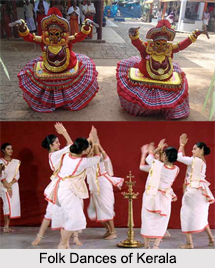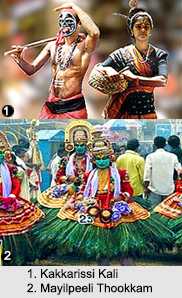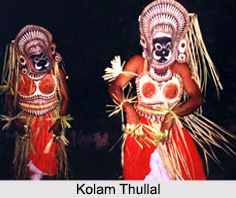 Folk Dances of Kerala reflect the temperaments and moods of the native people. Kerala has a rich variety of folk dances. There are around 50 popular folk dances in the state. Religious influence is explicitly visible in the dances which are performed during harvests, sowing of seeds, festivals, etc. Most of the folk dances of Kerala are accompanied by songs which are sung by the dancers themselves or occasionally by a group of musicians. The costumes and ornaments of these folk dances differ with places.
Folk Dances of Kerala reflect the temperaments and moods of the native people. Kerala has a rich variety of folk dances. There are around 50 popular folk dances in the state. Religious influence is explicitly visible in the dances which are performed during harvests, sowing of seeds, festivals, etc. Most of the folk dances of Kerala are accompanied by songs which are sung by the dancers themselves or occasionally by a group of musicians. The costumes and ornaments of these folk dances differ with places.
Some of the popular Folk Dances of Kerala are as follows:
Kakkarissi Kali
Kakkarissi Kali is a group dance which is prevalent among the Kuravas of Thiruvananthapuram district. It also contains wild beatings of primitive drums like Para, Veekkan, Chenda, etc.
 Dappu Kali
Dappu Kali
This dance is named as Dappu Kali because "dappu", a kind of musical instrument, is used in the dance. It is a group-dance of the Moplahs of Malabar.
Sarpam Thullal
Sarpam Thullal, a ritual folk dance of Kerala is done to appease the snake God in the temples. Many ancient families in Kerala have Kavus, which are the special snake shrines, whom they worship regularly, on various occasions.
Kaavadiyattom
Kaavadiyattom is mainly performed as an offering in temples of Lord Subrahmaniam. For performance, a number of dancers gather in temple, dressed in yellow or rose colour costumes. They stand in a row and dance with the rhythmic beatings of instruments like Udukku, Chenda and even Nadaswaram.
Kolkkali
This is a mixed dance in which both men and women participate. The performers move in a circle, striking small sticks and keeping rhythm with special steps. The circle expands and contracts as the dance progress.
Bhadrakali Thullal
This is a devotional offering of Pulayas and this is the only community who performs this ritual, for Goddess Bhadrakali.
Vela Kali
Vela Kali is a martial dance of the Nair community in Kerala. The dancers are all dressed in colourful costumes and arming with shining swords and shields, they dance with vigour and co-ordination.
Thiyyattu Dance
Thiyyattu is a devotional offering performed only in the Bhadrakali temples. The performers are known as "Thiyyattunnis". The theme behind its performance is usually the killing of demon Darika by Goddess Bhadrakali.
 Kolam Thullal
Kolam Thullal
Kolam Thullal is a ritual offering performed by village people, usually to get rid of the troubles and pains due to evil-spirits.
Thumpi Thullal
This is a dance in which only women can participate and it is usually performed in connection with the Onam festival. All the girls are dressed in a special type of dress known as Onakkodi dress and dance in a circle.
Kummi Dance
Kummi Dance is performed by women only and is very famous in different parts of Kerala. The dancers move in a circular direction and the hand gestures denote reaping and harvesting processes.
Kaduva Kali
This dance is also known as Pulikali. Dancers get dressed up as tigers along with appropriate costumes and make-up. They dance vigorously along with the loud beating of instruments like Udukku and Thakal.
Kanniyar Kali
It is being performed since centuries and is sometimes called as Desathukali. It is a fast moving, militant dance having pleasant rhythmic devotional folk songs. It is said to be a ritual offering in honour of the deity Bhagavathy.
Panna
Panna is a ritual dance in Kerala for propitiating Goddess Kali. A branch of the Pala tree is taken round the temple by about 10 to 12 persons who dance all the way to the rhythm set by percussion instruments and to the vociferous shouting and chanting of the accompanying crowd.
Thirayattom
Thirayattom is a ceremonial dance, which is performed as a vital part of festive celebrations in Kavus, in the Central Malabar region.
Kummatti Dance
Kummatti Dance is a mask dance mostly popular in South Malabar region of Kerala. The dancers wear brightly painted wooden masks on the faces while dancing.
Other Folk Dances of Kerala
Other popular folk dances of Kerala include Arjuna Nritham, Mudiyettu dance, Kuthiyottam dance, Poorakkali dance ,Garudan Thookam, Tholpavakoothu, Krishnanattam, Mayilattam, Kazhai Kothu, Margam Kali Dance and Sangha Kali.



















